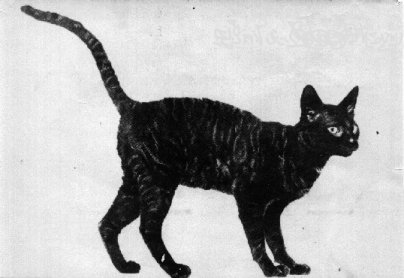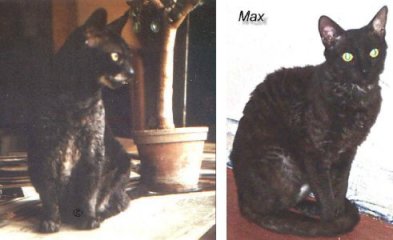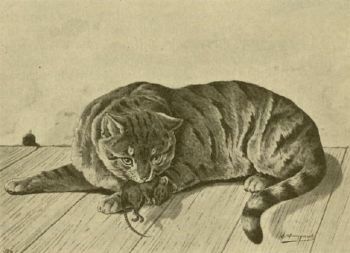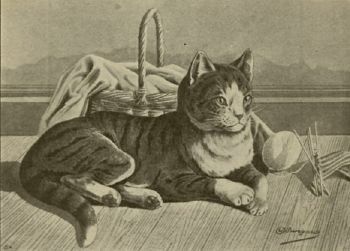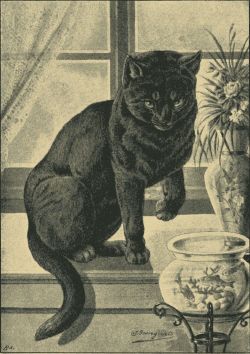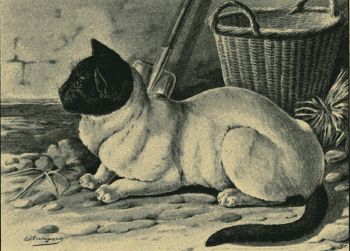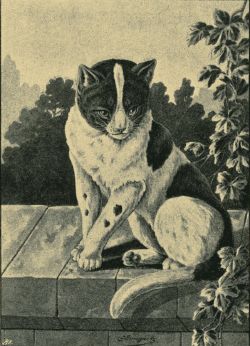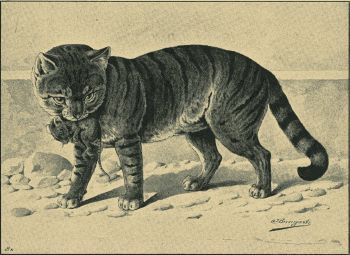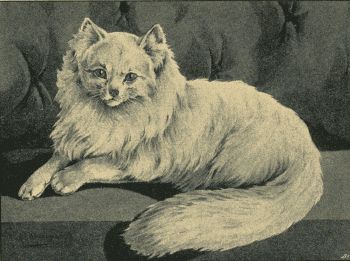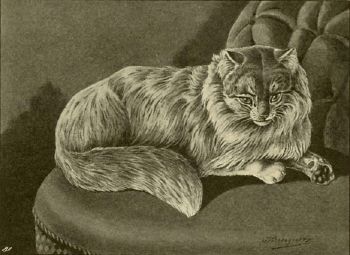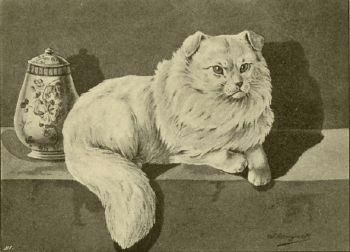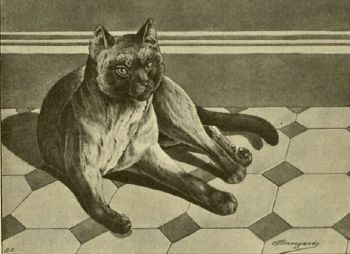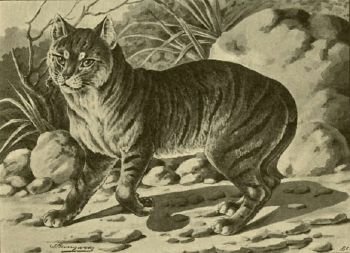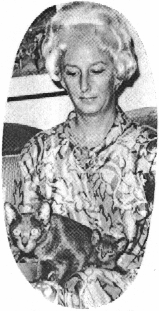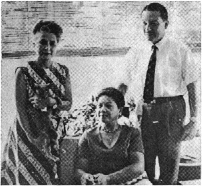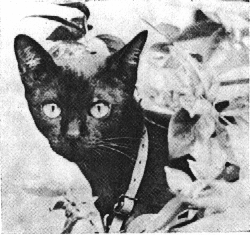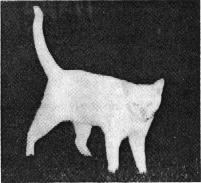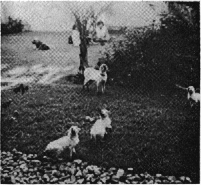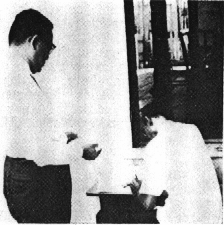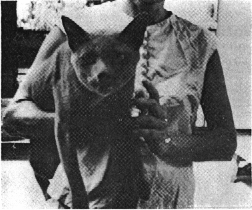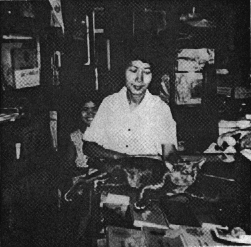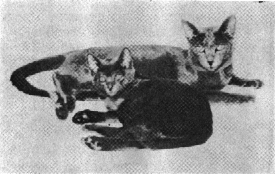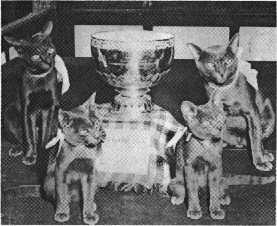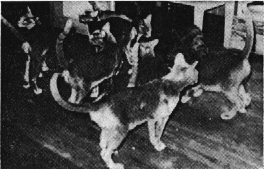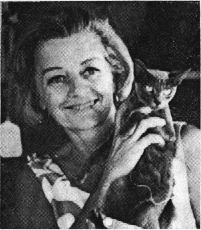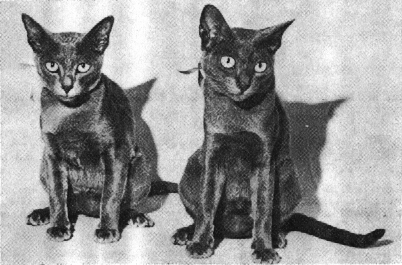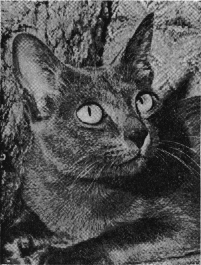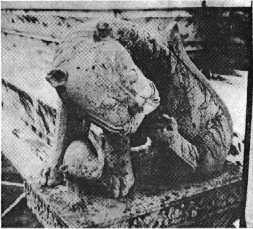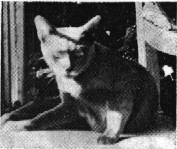Manual on how to treat a cat
[Translated into English by Karin Sandbergen.]
| Below you'll find the text of "Handleiding voor de behandeling van de Kat" by L.J. Quarles van Ufford, printed in 1934. The original language of this booklet is Dutch. | 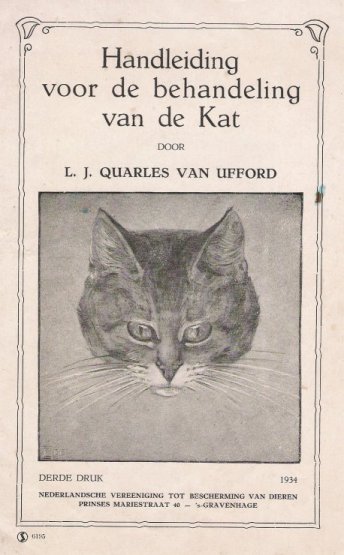 |
The Cat
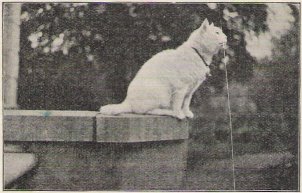 |
A slogan in a treatise about songbirds, caged birds and canary birds states: "One should empathise with their animals". With cats this is most certainly the case. Cats may be pets, but her wild nature has remained with her. No pet is therefore as wilful as the cat. One wants to take her to sit on their lap, she'll then jump off on the left, just to jump on from the right. To care well for an animal - a creature - one should learn about their physical well-being and especially their |
Character traits.
No two cats have the same character. A cat detests water on its skin. Yet, I heard about a cat that repeatedly swam across a ditch. I also knew of a cat that would sit on the bank of a stream for hours on end, fishing by striking out with her paw in the water. Once, she lost her balance and fell into the water. But she clambered out of the water very quickly, just to resume fishing.
It's sad that so many animals become a prey for cats. We judge the cat for continually going bird-hunting. But... we love it when she catches mice for us, which she treats in a very cruel way. What a contradiction!
Humans are like that, just like cats. And to learn about her true nature, one should empathise with their cat. One should observe and understand all about her quirks.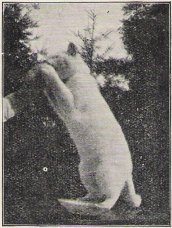 A cat is vicious! At least, that's what people say. I don't agree. On the other hand I venture to claim one can turn a cat, like all pets, into a gentle animal, just by the way they are brought up and handled.
A cat is vicious! At least, that's what people say. I don't agree. On the other hand I venture to claim one can turn a cat, like all pets, into a gentle animal, just by the way they are brought up and handled.
From the moment of birth one should inspire trust in her, handle her a lot, play with her and… talk to her, talk a lot and... talk softly.
That is why it makes such a difference, from which household the cat comes. One usually forgets one should categorise them under animals of prey. And no animal goes wild as quickly as a cat.
To tame a cat, to domesticate her and make her become attached to us, is a secret that's not known to everybody. One should love an animal and let it feel it's loved.
That a cat scratches us sometimes, is true. But this isn't viciousness, even though it seems that way! A cat uses its claws to hold on to things and to climb.
The cat's paw has 4 toes and a thumb and it's a peculiarity of the animal that she sometimes uses all 5 digits to hold on to something - just like monkeys and... we do.
When a cat holds on to us, we should take care extracting ourselves and never to withdraw our hand quickly.
We have a sweet cat that loves to climb onto our shoulders, especially when we're holding a little snack. But for the ladies it isn't pleasant when the cat's claws penetrate their shoulders, through the thin fabric of their clothes. However, is it then reasonable to speak of a vicious cat? ... Certainly not. When the cat grabs our hand to accept a nice titbit and we withdraw our hand, we wound ourselves on her claws, but we cannot declare the cat scratches us.
Enclosed photos show you our cat, taking a piece of liver, something she loves very much. Notice how she grabs the hand with her paws, but you can rest assured that she doesn't use her claws.
Whenever a cat strikes out with her claws, it's in self-defence, because she doesn't trust the situation.
Inspire trust in her and try to find out what she loves - for example in the area of her
Accommodation.
I've read somewhere, that a cat demands a pillow to sleep on, to curl itself gloriously up on it. This is somewhat exaggerated. For example, a cat loves to lie on paper, thin or thick. Take note: whenever the newspaper is on the table, pussycat will lie on it.
In the room where she slept, we had a so-called cat basket for our cat, but she never made use of it, or very rarely. It was a junk room with tall and low cupboards and on one of those cupboards, a cupboard hanging on the wall, she had her sleeping-place. How she reached that in the dark, has always remained a mystery to us. Even in broad daylight it was quite a feat. But on that cupboard stood a tool box and another box, about 30 centimetres long, 15 centimetres wide and 10 centimetres deep. That was her favourite bed. And sometimes she slept on top of the tools!
One night, the large dog had to spend the night in the room and the dog basket was placed there. Out of curiosity, because cats are highly inquisitive, pussycat was sitting in the middle of it very quickly.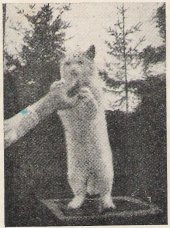 After we'd moved house, she got another room, of course, which had a different, large basket lying on its side. And, lo and behold, wasn't that delightful! Just as in later days, the junk cupboard - she always used to climb in, whenever the door was ajar.
After we'd moved house, she got another room, of course, which had a different, large basket lying on its side. And, lo and behold, wasn't that delightful! Just as in later days, the junk cupboard - she always used to climb in, whenever the door was ajar.
The morale of this all: try to find out which place the cat prefers most!
It's certain, that as a rule she prefers a very high sleeping-place. In the animal shelter in The Hague, in all the cages, there are little wooden boxes against the ceiling and they're favourite with all the cats. The animals can sit there peacefully. At the first renovation of the shelter, the department where the cats were kept was above that of the boarding dogs, under the roof. And it was already clear that the cats were always sitting on the beam, if it ran through their cage. That's why in every new cat accommodation, boxes were placed against the ceiling.
It's been a long time since in the old shelter an accommodation for cats was made. Information was acquired from England beforehand and the board of directors was informed of the fact that keeping a lot of cats together in one room was strongly frowned upon, as this was a cause of unhappiness in some animals, because of intimidation between cats. Also, contagious diseases and even deaths could be the consequence. This was the reason that in the The Hague animal shelter every cat had its own space. And with excellent result! One such space has a measure of one metre wide, 1½ metres deep and over 2 metres high. At 0.75 metre high there's a plank or table across the whole width, with a depth of about 80 centimetres. It has a sloping, ridged plank leaning against it, along which the animals can clamber up. The table has in one of its corners another, free-standing little table, under which a basket can be placed. During hot weather the cats got, instead of the basket, a sheet of paper, which they loved, but the shelter had to discontinue, because of scarcity of paper. On the ground stands the stone or enamelled box (cat's box), which is cleaned daily. Every day those boxes have to be cleaned, or else the cats become not house-trained. The box should contain dry (white) sand, sawdust or peat litter (not peat dust).
On the shelf one should place bowls with
Food and drink.
What should a cat eat? Anything that is on the menu. There are of course things they don't like, and what one cat loves, the other cat won't touch. That's how it works for us and that's how it also works for animals. But I'm willing to declare that all cats love oatmeal porridge. Our cat, for example, never likes to snack, but she can't resist porridge.
When feeding a cat, in the first place one should take notice of the condition of the cat. If she's young, if she's about to have kittens or just had them, if the tomcat is out on the roofs a lot and comes home with holes in his cheeks and covered in scratches, if it's summer or winter and also if she has recently been ill and needs building up a little. It is said that one should feed kittens raw meat, as soon as they want to take it. Although a little meat every now and again, isn't harmful, a diet that consists largely of meat will be very detrimental. Good, uncooked, tepid milk, porridge cooked with milk and, when the kitten is older, some cooked vegetables, lentils and peas in their own cooking water with broth is so much better, because it is more easily digestible.
After the cat has cut its permanent teeth, one may give them some lightly digestible meat. Good cat bread, cooked or softened with broth, is also excellent and although variety in food is necessary, it is recommended when acquiring a cat, to ask how she should be fed, because a sudden change in diet can be adverse.
It is impossible to give a universal instruction on how to feed a cat, because this is almost never the same for any two cats. A cat should finish a meal with taste and one shouldn't leave her food just "standing there". On the other hand one should never spoil their cat for simple food, by always feeding them fine food, like fried bones.
It is advisable to not always give softened and soft food. This is not good for the teeth, or for the intestines, because the stomach can't do its work properly and the gastric function is disturbed. The beneficial effect that saliva has on the digestion, will be eliminated.
Healthy cats like to munch on dry cakes, dried fish and meat.
That a cat needs two square meals a day is again not an axiom. However, one should always keep the following in mind: regularity, great hygiene in everything, variety in diet, enough but never too much and always clear water in abundance.
When the weather is cold one should try to raise the inner heat by giving more powerful food. Birds are given poppy seed. For cats, more meat and fish in somewhat larger quantities is very suitable. We've read in an English magazine, that one should give a cat more meat and fish, when she gets older. And, of course, it emerges that this also applies to cats that need building up and strengthening a little.
It occurs that cats, like dogs, don't like milk. In that case, give them some goat's milk, even watered down a little. They'll love it, of that we're convinced.
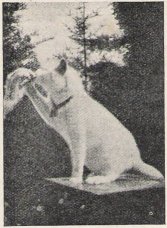 In an English book we read that one should give cats uncooked milk. It doesn't explain why. Isn't it possible that they, like many among us, don't appreciate the unnatural "cooking taste"? An expert, with whom we spoke about it, didn't want to assert that cats aren't susceptible to typhoid, foot-and-mouth disease or tuberculosis, which is why we cook the milk. But he declared that uncooked milk is more nutritious. In our opinion, one could give goat's milk, because of the special way we keep goats - contrary to other cattle - properly, without cooking it, and that therein lies the secret.
In an English book we read that one should give cats uncooked milk. It doesn't explain why. Isn't it possible that they, like many among us, don't appreciate the unnatural "cooking taste"? An expert, with whom we spoke about it, didn't want to assert that cats aren't susceptible to typhoid, foot-and-mouth disease or tuberculosis, which is why we cook the milk. But he declared that uncooked milk is more nutritious. In our opinion, one could give goat's milk, because of the special way we keep goats - contrary to other cattle - properly, without cooking it, and that therein lies the secret.
Bread, preferably stale, is also a main diet staple and is given soaked in milk. For cats that don't want to eat it, one mixes it with solid food.
In England exhibitions are the order of the day and they have so much success, that one keeps animals only for that purpose. Without wanting to come across as a champion of the exhibiting of animals, I cannot help but think that the English exhibitions have a wholesome effect on the care of the animals, because the condition the animals should be in at the show, are subject to criticism of a jury. People go as far as to feed their pets only animal food and, as variety in diet is advisable, give them meat one day and the other day, fish.
For cats that are "off their food" one recommends ox liver, cooked and then hard-fried and grated over the food. This will soon have them eating again. Now, there are small eaters under cats, that haven't therefore gone off their food, while one also mistakes greediness for hunger.
It's very curious how we're always looking for strengthening food and throw away the best of the food. Thus, we usually throw away the water the vegetables are cooked in, while it's rich in nutrients. We use it, instead of water, to moisten the food of dog and cat. So it seems that limewater is very beneficial, especially for young cats. It suffices us by giving a teaspoon full of phosphoric acid (bone meal) that in small quantities is so advantageous for the bones. Bigger quantities give cause for constipation.
English breeders allege that no nutrient has so much healing power as grass. They go as far as to sow grass in pots and subsequently place them in reach of their cats, whenever there isn't a lawn in the vicinity to let their cats loose on.
It can also be a need to bite into something, to use the teeth, as well as a need for certain ingredients and stimulants (nutrients).
Illnesses, injuries, etc.
Next, from the nature of things we'll only mention so-called home remedies and it can therefore merely serve as first aid in case of accidents. Illnesses and injuries of a serious nature, should be treated by veterinarians.
The prescribed treatment by a veterinarian isn't to be carried out easily by a layman. For example giving food, liquid or solid. If it's difficult to treat a cat, in the first place one should take care that the animal can't offer any resistance and will scratch. To that purpose, one wraps a large cloth around the body and with it, the paws. To pour down a medicine one shouldn't break open the mouth, but leave it closed. One simply sticks an index finger in the mouth of the animal, between the cheeks and molars and in that way form a little pocket, wherein one pours down the medicine in small amounts. The easiest way is to make use of a pharmacy bottle of approximately 20 grams, wherein one has put the specific amount. For pouring down castor oil one takes a bigger bottle, otherwise one can't pour down enough. By putting it in a cup of warm water, one can make the castor oil in the bottle more liquid and thinner. By putting the bottle against one's (closed) eye or against the cheek, one can judge if it's not too warm. When pussycat doesn't want to swallow, one should pinch her nose for a moment. The head should be kept upright during this process.
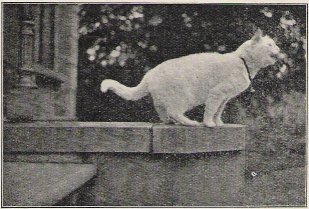 Pills should be placed on the back of the tongue, as deeply as possible. Powders should, for all intents and purposes, be placed in the same place. Powders are given more easily, because the powder will soon adhere to the mucosa and nothing is lost, except that, which is coughed away. Powders can also be given in stiffly beaten egg whites.
Pills should be placed on the back of the tongue, as deeply as possible. Powders should, for all intents and purposes, be placed in the same place. Powders are given more easily, because the powder will soon adhere to the mucosa and nothing is lost, except that, which is coughed away. Powders can also be given in stiffly beaten egg whites.
Subsequently, we only want to discuss the cases that can easily be treated by laymen, for example:
Mild ear infection
One notices very swiftly whether a cat suffers from that, for example, because it scratches itself with its hind leg. It can be cause for injury, but the ailment itself is the result of inflammation of the skin of the auditory duct, which discharges a very unpleasantly smelling fluid and is the cause for contamination. One regards the poor animal. It lowers the diseased ear and it shakes its head continuously.
When one empathises with their animals, one notices immediately what's going on and then treatment is simple. One turns a piece of surgical cotton wool around the end of a matchstick, from which the sharp edges have been removed and cleans the ear with that, there where it's giving trouble and one also cleans all the folds of the ear. One can go quite deeply, but one should be very careful not to touch the eardrum! If the cotton wool - one prepares about four or five beforehand - doesn't get dirty anymore, then, in the same way, one puts a piece of cotton wool with boracic ointment into the ear. Within a few times the complaint should be remedied.
The piece of wood shouldn't injure the ear.
When the infection is more significant, one should call in the help of a veterinarian.
It could also be caused by warts and what one calls, cancer of the ear. In this case the veterinarian should also interfere.
To see deeply into the auditory duct, one should pull the auricle a little.
Digestive defects
It isn't advisable to give purgatives. When it's a case of constipation, one does best to give some cooked vegetables or some salad oil. The oil from sardines is also very good and when one mixes it with some drops of castor oil, this will be lapped up eagerly.
Nor is it advisable to combat thin faeces with certain astringents. A chance in diet, for example with some rice, is then to be recommended. Does the ailment become more serious, one should seek help from a veterinarian.
Fits or seizures
It happens that a cat seems very healthy, then suddenly collapses and becomes convulsed, to slowly and dazedly regain consciousness after a few moments, while liquid and mucus come from the mouth. Such attacks can have many different causes. One shouldn't neglect to consult a veterinarian.
Awkward visitors
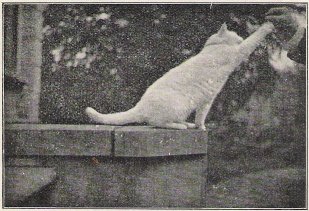 Earlier, we discussed greediness. This greediness can be caused by worms and in that case the animal can eat as much as it likes and still stay skinny. Does it therefore attract your attention that your animal displays an extraordinary appetite, convince yourself that there are fragments of worms in her box, smaller or bigger white sections, which point to her having worms. In that case a veterinarian should prescribe a remedy for your cat.Tapeworms secrete elongated sections of 1 centimetre long and 3 millimetres wide.
Earlier, we discussed greediness. This greediness can be caused by worms and in that case the animal can eat as much as it likes and still stay skinny. Does it therefore attract your attention that your animal displays an extraordinary appetite, convince yourself that there are fragments of worms in her box, smaller or bigger white sections, which point to her having worms. In that case a veterinarian should prescribe a remedy for your cat.Tapeworms secrete elongated sections of 1 centimetre long and 3 millimetres wide.
It won't be necessary to mention that the flea too, is an unpleasant and awkward animal. Certainly for cats and not in the least for the long-haired ones, because her fur is very woolly and dense.
One combs the animals and washes them with the more harmless detergents that are available. One can get information about it from any veterinarian, pet clinic or animal shelter.
The basket and sleeping-place of the cat should also be cleaned thoroughly, because these can - and will - be contaminated by eggs and larvae.
The cat louse is a grey and yellow insect with an oval body, approximately the size of a pin-head. It can usually be found there, were the cat can't reach with their paws and on the bodies of unkempt and weakened animals. The parasite causes a sort of dandruff, by which it can be recognised, but first one discovers numerous nits or eggs, that are placed obliquely on the hairs.
To cure the cat of this, with good result, one should, at the same time when one is fighting the lice, let the cat recuperate. Since the skin of these cats is especially dry, one should give them as much fat as possible.
There are detergents available, which are not poisonous, but one should remember, that carbolic acid, lysol, creolin and other such remedies will be absorbed into their skin and can be lethal. The so-called cologne for the hair is also wrong.
 Mange
Mange
This is an illness of a much serious nature and also much harder to cure. The parasite that causes her, belongs to the mites (Acarids) and looks like the cheesemite. She's so very small, that she can't be seen with the bare eye. But, as small as she is, she's incredibly fertile. She digs herself into the skin and lays about 24 eggs there. These hatch within the space of a week and after a few weeks these young also lay eggs. And thus, reproduction goes so fast, that there are 1,000,000 offspring within 90 days!
A cat gets mange by coming into contact with cats that are already infected. The illness can pass on to dogs and even people. Luckily, not every skin disorder is mange. Don't get inordinately afraid, but be careful and consult the veterinarian as soon as you notice bald spots on the skin, around the eyes, on the ears etc. of your cat.
Wounds
During treatment of wounds great hygiene is a prerequisite and one should keep the wounds as clean as possible. However, many disinfectants are poisonous for cats, so that one should be very careful. A good remedy is potassium permanganate 1 : 300. Also, hydrogen superoxide H2O2 and 2% sodium carbonate solution. It's better to prevent than to cure. Of course, one can't prevent a cat getting bitten or cutting itself by falling through a window, for example. What one can prevent is that pussycat plays with the pins and needles on the pincushion. Cats seem to love those ladies' articles very much and they also seem to taste very well. Repeatedly, cats have to be treated because a needle or pin is lodged in their throat. I even know about a case, where a cat had swallowed a 17 centimetres long hatpin, with the head downwards.
Needless to say, that even in such cases the help of a veterinarian should be sought, since it certainly requires the cat to be brought under an anaesthetic.
But one should also take care that pussycat doesn't get hold of large bones of birds, because the fragments of these bones are so sharp, that they usually become lodged in the intestines and the animal needs to have an operation. That is, if one discovers what's ailing pussycat!
Operated on - under anaesthetic. Because an
Anaesthetic
Is always to be preferred, since the physician can then perform in a more peaceful way, therefore won't wound the animal unnecessarily and, which is of great importance, won't torture the animal by the enormous fear it would experience during the operation. The wound of an animal, that's operated on under anaesthetic, heals much better and more rapidly, because the animal, at least the first days, the days so much depend upon, won't be aware of what has happened. An animal, that's operated on while fully conscious, will quickly start trying to tear off its bandages.
Burns
These, one treats as quickly as possible with lots of boracic ointment or vaseline and even butter is excellent for the first treatment.
Listlessness
Sick cats, cats that are apathetic, that have no appetite, without us knowing what is wrong with them. In Japan one is in the habit of giving a raw egg and one claims that they've subsequently recovered.
It should be put to the test, once.
Prior to ending this essay, we would like to warn against the results of the great curiosity of these animals.
It seems that a cat has the need to go exploring everywhere and therefore crawls into every hole, which she can barely fit into. For example, how often does one hear about cats that have become stuck under floorboards or bricked in behind walls or locked up in cupboards and thereby got lost? Recently, I heard about a black cat, which crawled into a stove, after which it was closed and the stove lit.
It was only by great coincidence that the cat was saved just in time.
Tomcats, which aren't neutered, are as a rule - during certain times - not house-trained. At the age of six months (or older) the neutering can be performed by the veterinarian under anaesthetic, completely free of pain and safe.
This is to be recommended.
The killing
After all is said and done, there's still this: To give a cat or dog, that's critically injured or incurably ill, a peaceful death, one does best to consult a veterinarian, who'll decide, in every separate case, which is the best way to release the animal out of its misery.
The revival of the German Rex
By Tony Batchelor, Snugglebugs, Denmark.
(Reprinted with permission)
First I will tell the story from the earliest days to the present. I will then add an appendix that attempts to summarise the known facts regarding the mutation that started the breed, together with some speculations of my own about the later genetic inheritance.
 The story of the German Rex as a recognised breed began when a kitten was born in Berlin to otherwise normal house cats. That was in 1947. That black female kitten had a curly coat and was left to wander freely with no particular notice being taken of her appearance. She seems to have needed to find herself a home, and was eventually adopted by nurses working at the Berlin Hufeland hospital. Now, almost sixty years later, the story seems to have come full circle with another stray Berlin cat becoming part of the revival of the breed. This modern addition to the story is a recent addendum to my appendix.
The story of the German Rex as a recognised breed began when a kitten was born in Berlin to otherwise normal house cats. That was in 1947. That black female kitten had a curly coat and was left to wander freely with no particular notice being taken of her appearance. She seems to have needed to find herself a home, and was eventually adopted by nurses working at the Berlin Hufeland hospital. Now, almost sixty years later, the story seems to have come full circle with another stray Berlin cat becoming part of the revival of the breed. This modern addition to the story is a recent addendum to my appendix.
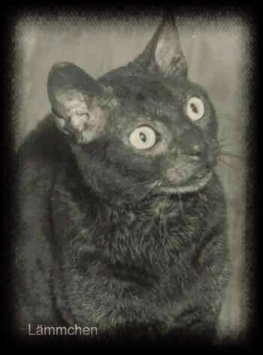 In the summer of 1951 a doctor, Dr Rose Scheur-Karpin, noticed in the hospital garden, that black, curly coated, cat. The doctor adopted her and named the cat Lämmchen (German for little lamb). Her supposition that she must be the result of a mutation, was later shown to be correct as the result of some studies done in Britain in 1956 that compared Lämmchen to another curly-coated breed that was discovered in Cornwall in 1950. Thus Lämmchen was in fact the first breeder-owned rex-type cat and the maternal ancestor of all the German Rex cats. Just for accuracy, I must mention that another "German Rex" was reported in 1931, not far from Berlin, but no breeder was ever known to have been involved. It is interesting now to speculate that Lämmchen may have been descended from him!
In the summer of 1951 a doctor, Dr Rose Scheur-Karpin, noticed in the hospital garden, that black, curly coated, cat. The doctor adopted her and named the cat Lämmchen (German for little lamb). Her supposition that she must be the result of a mutation, was later shown to be correct as the result of some studies done in Britain in 1956 that compared Lämmchen to another curly-coated breed that was discovered in Cornwall in 1950. Thus Lämmchen was in fact the first breeder-owned rex-type cat and the maternal ancestor of all the German Rex cats. Just for accuracy, I must mention that another "German Rex" was reported in 1931, not far from Berlin, but no breeder was ever known to have been involved. It is interesting now to speculate that Lämmchen may have been descended from him!
Lämmchen had many kittens but most are unaccounted for prior to Rose adopting her. Even her later ones are largely untraceable, but I can account for about 60 from notes made by Rose. Whether or not any were sterilised cannot be known for certain, so the conclusion must be that there are still domestic cats in and around Berlin that carry Lämmchen's inheritance to this day! See addendum
Various breeders in East Germany (as it then was) took curly-coated kittens from Rose and between them they were successful in breeding more German Rex. By 1957 a kitten had already been sent to a British breeder, but unfortunately it died soon after arrival. In 1960 others went to Paris but due to mistakes by the airline, the cats died on the way. Later that year there was better success and one cat was shown in public outside East Germany. Finally, in 1961, cats went to the USA where some enthusiastic breeders got together there and produced many cats that became well known in GRX pedigrees. The records of Lämmchen's offspring continue up to 1962 when she had her last. Lämmchen died in 1964, and by 1968, there were only three direct descendents of Lämmchen known.
After 1968 all seemed to be well for the breed as in later years both European and American breeders produced many good cats, and obtained recognition for the breed in their respective cat breeder organisations.
Going back a few years, it is only thanks to the Barensfeld family (breeders in Grund in East Berlin) that the few wonderful German pedigree cats were protected. The three known animals from that breeder were Ferdi, Roland and Silke von Grund. In the beginning the Barensfeld family knew nothing of the new Rex mutations in England, or of the crossed Devon Rex in the breed that arose from early genetic experiments that mistakenly assumed that there was only one rex mutation.
Up to now the old breeders of the GDR are always forgotten in the published stories although in the early days they played a major part. The first registered GRX breeder was Mr. Barensfeld (and judge in the GDR) who received the first GRX from Mrs. Gertraute Knuth (nurse in the Hufeland Hospital at Berlin-Buch, a colleague of Dr. Rose Scheur-Karpin). There was also the family Kania (cattery: vom Jagdrain) and Thomas Hamann (cattery vom Hause Hamann since 1985) who both had a large portion of the GRX breed in the former East Germany. The Woellner family received their first GRX from Mr. Barensfeld. With the breakdown of the barriers between the two Germanys in 1989/90, the way was open to better development of the breed. This did not turn out quite as anticipated!
|
Christopher Columbus, 1961 |
Earlier in the USA the breeders there attracted a lot of attention initially, but somewhere along the way the impetus died out. Amongst other things that happened was the production of a new cat magazine called The Forum that featured the GRX in articles as early as 1971. But despite all that happened in the 1960's, by 1970 the record stops with the last known American kittens born and soon breeding seems to have stopped altogether. As an indication of the decline in the breeds fortunes in America, in 2005 the American Cat Fancy Association (CFA) did not even have a record in their office that the GRX had been recognised by them and registered there!
Generally the breed had poor penetration against the other curly breeds. In the last decade the GRX breeders would have succumbed if it had not been for the efforts of the Swiss breeder Fru Schwarzenbach (as Frizzled Frolic) who took the initiative to revive the breed. This is how it happened.
By 1999 there were only two fertile German Rex females known in the world, Batu Happy von Quiomme and Bonsai the Frizzled Frolic - there were no tomcats! The situation was apparently saved when a response to an advertisement searching for any fertiles was received in 2000, from a cat rescue centre. They said that they had two cats, and knew of a breeder who was giving up who had others and suddenly decided to give all his cats to any breeders who could take them! The situation appeared to be saved!
Then the situation became, if anything, even worse. When the cat rescue people (who were brought in again by that breeder) tried to collect the cats a fertile male panicked, hit its head and had to be destroyed. A female (Gretel) was pregnant and the foetuses died. To save Gretel she had to be sterilised. The remaining cats were so little used to human company or were sick so that they died soon after the rescue attempt - the end result, a lot of heartache and a few pet cats.
Then the situation deteriorated further in 2000 as Happy herself had problems. Born in 1997 she was received in June 2000 in a not very good condition; disturbed and with a uterus- inflammation. It was even more essential that she was mated before she became so bad that she would have to be sterilised to save her life. Mating should succeed and would probably help to clear up the inflammation. A decision was made by her owner and the few breeders still wanting to be involved to find a stud of another breed, and in a hurry! Available was an Abyssinian. This was suggested and accepted after further consultation, as it would give the correct type, if successful. Let me quote from a letter I have that told the story in the owner's own words - 'It functioned. The first hybrids were received with joy. All wanted at that time!!! But I did not have relations with a breed committee, that approves this mating.'
To keep the breed active the decision was taken to register the kittens as if they had a housecat as a father, and thus "Maximillian" was created. Again I quote - '"Maximillian" was a creation ;-) I would have never got the permission from her club to mate Happy to my Abyssinian "Puschkin". So we created the cat "Maximillian" a black-ticked housecat.'
|
Dr. Rose, Kater Munk, Lämmchen and kittens |
Matters were left as they were for a few years until the four hybrid offspring from that mating had themselves been mated. It was the only mating from "Maximillian" as he died in September 2000. In 2001 Bonsai was mated to one of Happy's offspring, Boogie Curlyhead vom Batu, and produced one GRX kitten. In addition there was a female who was only a few months old in 2000, Chuba Chups the Frizzled Frolic. She was also mated to Boogie in 2001 and that also produced one GRX kitten. Thus the revival started with Happy and Puschkin and continued with Bonsai.
So that is how I found the pedigree information when I got my first German Rex in 2004, and at the same time became the GRX database maintainer for PawPeds. However, in April 2005, Happy's owner decided that it was necessary to correct the pedigree record and contacted the DEKZV registrar to put their records straight. The DEKZV breed committee agreed that the circumstances in 2000 had been so unusual that they could retroactively approve the mating, and thus "Maximillian" was revealed in his true identity as Segena's Puschkin, a ABY n, born in 1993.
In this story I have not included all the names of those involved, as it is sometimes difficult to be sure of getting them all. So rather than offend by including some names and not others, I have just mentioned those people well known in the historical record.
(Not so well known is that in this frequently used illustration, Rose and Lämmchen could never have met Kater Munk!)
© Tony Batchelor, February 2006, Odense
Appendix - May 2005
Is the genetic structure of the modern GRX as good as it should be?
Just how much of Lämmchen's inheritance is in the modern cat? For example, Evelyna, my six months old cat has Lämmchen appear just five times in her pedigree, in the ninth and tenth generations, but over the same time span, there are eleven CRX appearances. (These figures currently based on the present stage of the GRX database.)
Just a few odd thoughts to connect some facts:
In the history of rexed cats, there have been three main types accepted and bred by the cat fancy in the 20th century. There have been others, but they are a minority and mostly later. There are also differences such as the Selkirk in which the mutated gene is a dominant and not a recessive.
In the various descriptions of the rexes, it has been common practice to distinguish the mutations by naming them Gene 1 and Gene 2. I wonder if in fact that is sufficient to adequately describe all of the modern rexes? For example, in the rabbit there are at least three, only one of which has wavy fur.
I will start with a brief history of each from the standpoint of the genetic structure. Of course, I am not a geneticist, so my point of view is merely to correlate the writings of other authors, together with some logical deductions of my own.
It is apparent that there have been "curly cat" mutations in much earlier times than the cat fancy has recognised them! Even in the older books that first mentioned the two English rexes, authors recall even earlier stories of "children cuddling curly coated kittens". This is similar to another well-known coat mutation; that of the Sphynx. In that breed we even have photographic evidence from 1902 that so-called hairless cats are viable, and that is from the south of North America, whereas the 1960's foundation cats came from similar mutations thousands of km away in the cold north!
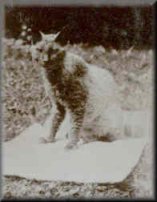 The first reported rex mutation in the cat appears to be from the 1930's (1930/1) in Prussian Germany from Konningsberg (now in Russia). Luckily photos of Kater Munk exist, although there does not seem to have been either any useful reporting, investigation or attempted or even any known but accidental breeding from him. The later rexes in Germany were reported from places far distant, at least in cat terms, at Berlin, Essen and Siegburg. It is therefore statistically improbable that they were identical mutations.
The first reported rex mutation in the cat appears to be from the 1930's (1930/1) in Prussian Germany from Konningsberg (now in Russia). Luckily photos of Kater Munk exist, although there does not seem to have been either any useful reporting, investigation or attempted or even any known but accidental breeding from him. The later rexes in Germany were reported from places far distant, at least in cat terms, at Berlin, Essen and Siegburg. It is therefore statistically improbable that they were identical mutations.
The second reported rex mutation in the cat is better documented and was in the county of Cornwall in the southwest of England. That was in 1950. Research by Jude and others at the time proved that a recessive gene carries this mutation, and they later termed it Gene 1. For reasons that will become apparent later, I term it gene cr from the name given to the breed, Cornish Rex.
The third reported rex mutation in the cat was again well documented by Jude and his later co-researcher and author, Searle. This cat, Lämmchen, was near Berlin in Germany, which is over 550km distant from Konningsberg. A decade later, experimental breeding showed that the new cat did not have any compatibility with the Devon Rex. However, earlier breeding with the Cornish Rex did result in further rexes. It was therefore assumed (my emphasis) that the gene mutation was the same, although it was not possible at the time to test this by actual gene inspection - for example by DNA tests - so I will give it another name, gene gr from the name, German Rex. As far as I am aware, there has still been no confirmation by DNA analysis.
The fourth reported rex mutation in the cat was also well documented (and created great interest amongst the breeders and researchers) and was in the county of Devon that borders Cornwall. As the two nearest towns are 80km apart, again it was thought unlikely, purely from the statistical point of view, that there was any connection. As it soon became clear that breeding this type of cat together with either of the other two did not produce more rexes, that lack of any connection was proved. The name given was Gene 2, but I will be using the name gene dr from the name, Devon Rex.
The fifth (and sixth) reported rex mutation in the cat is comparatively recent, appears to have happened twice, and is not so well documented. They were both from Lanzarote in the Canaries - one in about 1981 and one in 2000. The nineteen years separating the two cats does not apparently give any direct connection, which could have been expected if they were descended from an import! Therefore I have to consider these as two more mutations and will give them the names gene lr and gene lr2 from Lanzarote.
The seventh reported rex mutation in the cat (Preuss from Siegburg) was a little earlier than my fifth and sixth above, in 1979, but I do not consider this cat relevant to the other mutations for the reason that mating to another GRX type only produced two straight haired kittens. Those two kittens were subsequently mated with each other and produced one cat described as a GRX, but I consider that pedigree to be rather suspect. If the mutation was genuine, then it could be called gene sr. Incidentally, one distance involved is comparatively short in our terms, but not perhaps, from a cat's viewpoint! Siegburg is only about 100km from Essen, but 470km from Berlin.
Further work needs to be undertaken to establish if any part at all of Lämmchen's genetic inheritance is left in the modern breed! My reasons for putting this question are as follows:
- From the above, it is known that there have been three additional mutations that appear to give German Rex cats. I define the "real" German Rex as only those cats that have the gene type I have designated gene gr.
- I believe that there is no actual proof that her gene is any longer in the GRX gene pool.
- Statistically, I would consider that it is more likely that the modern GRX type cat is merely a gene cr coated cat with a DOM body structure (but, see my appendix).
- It is necessary to take in to consideration the fact that individual gene mutations at the same locus need not be of the same gene to give similar effects on later generations.
How can this supposition be tested? There seems to me to be two possibilities.
- In 1956 Searle and Jude investigated rexing in the cat. At that date they only knew of two types that they called the English and the German. We now know them as CRX and GRX. In their research they compared hair samples from a CRX (cat not stated) and from Lämmchen. Thus a similar comparison of modern cats with their 1956 microscope derived drawings might well yield valuable information.
- More accurate, but also more difficult, would be a full investigation leading to an analysis of the genetic structure itself - a "DNA test".
Tentative conclusion:
Until some physical research is possible to prove matters one way or the other, I propose that it is necessary to conclude that the modern GRX is unlikely to have evolved from the gene type gene gr but from the gene type gene cr to control the coat and various DOM cats that simulate the body structure of the early GRX. But, see my recent addendum.
If that conclusion is not correct, then great care is necessary to avoid the introduction of even more of the gene type gene cr, and instead breed for greater penetration of the correct gene type gene gr. (Referring to my addendum, this may be about to happen!)
However, if that conclusion is correct, then it has to be acknowledged and breeding plans modified accordingly as soon as is possible.
In either case, it is important that very careful thought is given to the updating of the GRX Standard.
Tony Batchelor, May 2005, Odense
Addendum March 2006
Shortly after writing the above in 2005, a hitherto unknown breeder contacted the GRXCC for advice on homing two litters of German Rex!!! The cattery is Moorteich and is in Stralsund, northeast Germany, about 250km from Berlin. On the face of it, a long 'cat distance' which implies another mutation? However, it soon became clear that this introduction could mean a lot more than that, as follows:
|
Lämmchen (left) and Max (right) |
The mother of the last litter is a GRX called Diana who was bred from well-known lines. The father, Max, is also a full GRX, and his parents, grandparents and some great grandparents are known. All six kittens in the litter (Moorteich's G litter) are now registered as GRX and they will be used by some existing GRX breeders as potential parents.
Using my originally outlined suggestions, the possibility that Max is yet another mutation immediately came to mind, until more information emerged only a few days ago. Max was bought through an advertisement offering Max for sale in Berlin.
Max's grandmother on his father's side, and his great grandmother on his mother's side, is Pumina. Pumina was a black curly-coated cat found on a construction site in the Wedding quarter of Berlin. After changing hands three times, she was homed elsewhere in Berlin where she had a last litter. She was born in 1993, and although only living for two years, in that time she had several litters, nearly all of which were not curly. Where most of those kittens went is not known, but inbreeding of five of the kittens (natural, not planned!) eventually ended up with a litter of Max and his sister who was not curly.
The Hufeland Hospital where Lämmchen was found has since been relocated, but the buildings are still there at Karower Strasse 11. Pumina was found only 14km away.
Now we would appear to have a very good possibility that Max is in fact a descendant of one of the many Lämmchen kittens that were spread so widely around Berlin in the 1950's and 60's. More research will now be attempted into Max's background to see if he might carry the genuine gene gr. Is Lämmchen here seen looking at her descendant of almost 60 years later?
Tony Batchelor, April 2006, Odense
| Illustriertes Katzenbuch | 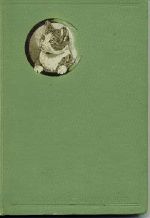 |
By Jean Bungartz, printed in Berlin 1896.
Here we present a chapter from "Illustriertes Katzenbuch", written by Jean Bungartz in 1896. Bungartz has also made the beautiful drawings of the cats in the book.
The original language in this book is German.
In Bezug auf Bildungen von Rassen, hat die Hauskatze so Ziemlich ihre Selbständigkeit gewahrt und sich wenig verändert. Bei allen anderen Haustieren finden wir eine Menge Rassen und Varietäten, dagegen sind diese bei der Hauskatze sehr spärlich vertreten. Ihr ungebundenes Leben, ihr Freiheitsdrang, ihre Selbständigkeit und Eigenliebe, ließen eine Zucht im Sinne der heutigen Zuchtregeln nicht zu da sie sich nur sehr schwer in die beengenden Verhältnisse derselben pressen läßt und Umbildungen, die sie allenfalls durchgemacht, sind höchstens in der Farbe und der Struktur des Haares zu erkennen und wahrzunehmen. Im Körperbau ist sie dieselbe gebleiben, und eine wirkliche Abänderung in gewissen Körperteilen lassen sich höchstens bei der hängeohrigen Katze aus China und bei der schwanzlosen Katze von der Insel Man (zu England gehörige Insel in der Irischen See) feststellen.
|
Fig. 8. Wildfarbige oder graue und schwarzgestreifte |
Über die Körpermerkmale der Hauskatze ist bereits in einem vorhergehenden Abschnitt das nötige gesagt, und es erübrigt hier nur noch einiges über die festen Farben nachzutragen und dann die ausländischen Rassen und Varietäten anzuführen. Zunächst dürfte, als schönste Färbung, die wildfarbige oder graue und schwarzgestreifte Varietät der Hauskatze (Fig. 8), als die Urfarbe angesprochen werden, aus der sich in der Folge die anderen Farben entwickelten. Diese Varietät kommt der wilden Katze in der Farbe ziemlich nahe, und sind es besonders große und starke Exemplare, so wird sie leicht von Unkundigen mit dieser verwechselt, wenn nicht das untrügliche Zeichen, die längere und spitzere Rute vorhanden wäre. |
|
Fig. 9. Graue Hauskatze mit weißen Abzeichen. |
Die Grundfarbe ist mehr gelbgrau, das Gelbe an den Läufen, der Brust, nach dem Bauche zu und im Gesicht etwas auffallender; der Körper ist mit dunklen schwarzgrauen Querstreifen und Binden geziert. Katzen, die statt der Quer-, Längsstreifen zeigen, zählen zu den großen Setlenheiten. Das Auge ist grünlich-gelb, die Nase, sowie die Lippen und auch vielfach die Sohlen schwarz oder doch wenigstens schwarz gefleckt. Diese Varietät ist auch meist wilder, wie die übrigen, zeichnet sich durch größeren Selbsterhaltungstrieb aus, verwildert leichter und paart sich auch am ehesten mit der Wildkatze, deren ganzen Charakter sie annimmt, wenn sie die Wohnung des Menschen verläßt und draußen wildernd umherstreift. Man ist allgemein der Ansicht, daß sie die beste Mausekatze ist. |
|
Fig. 10. Schwarze Hauskatze. |
Eine ihr nahe kommende Varietät ist die mehr blaugraue gestreifte Katze (Fig. 9), die in der Regel weiße Abzeichen an Gesicht, Brust, Fuß und Schwanzspitze ausweist und nicht die Stärke der ersteren erreicht. Die schwarze Varietät (Fig. 10) in reiner Farbe, ohne rötlichen Anflug und weißliche Abzeichen mit schön gelben Augen ist entschieden die schönste aber auch die am seltensten vorkommende. Sie gleicht, abgesehen von der Größe, dem schwarzen Sunda-Panther. In der Regel hat die schwarze Farbe, im Sonnenlicht oder heller Beleuchtung gefehen, einen bräunlichen Anflug; dann erscheinen euch wohl bei der einen oder anderen die dunkeln Querbinden, wenn auch sehr undeutlich und das Auge zeigt nicht die schöne hellgelbe Farbe. Wirklich schwarze Katzen ohne irgend einen anderen Beiton oder das geringste weiße Abgezeichen, sind herrliche Tiere und deren Fell ist ein sehr gesuchter und gut bezahlter Artikel. Die weiße Varietät (Fig. 11) ist ziemlich gemein und man hält sie für sehr weichlich und nicht so widerstandsfähig wie die vorigen. Obschon weiße Katzen mit blauen Augen, im sauberen Haarkleid recht anmutige Tiere sind, sieht man sie in den Städten doch recht selten in properem Zustande.
|
|
Fig. 11. Weiße Hauskatze. |
Meist ist das Haar struppig und glanzlos, und doch könnte bei ihr eine sorgfältige Haarpflege vieles thun, um sie ansehnlicher zu machen. Viele weiße Katzen sind, wenn nicht ganz taub, so doch in der Mehrzahl schlecht von Gehör und infolgedessen minderwertige Mauser. Ein hübsches weißes Kätzchen, in guter Pflege und recht sauber gehalten, hat immer etwas Apartes für sich. Die Maskenkatze ist in der Regel tiefschwarz, zwischen den Augen befindet sich eine weiße Schnippe, ebenso sind Lippen, Schnurrhaare, ein Fleck an der Brust, der manchmal bis zur Kehle hinaufgeht, die untere Bauchseite und Pfoten reinweiß; auch bei einigen noch die Schwanzspitze. Die Augen sind bei dieser Varietät gelb und erscheinen die schwarze Umrahmung ziemlich leuchtend. Je regelmäßiger und bestimmter die weißen Abzeichen und je schärfer diese sich von der schwarzen Grundfarbe trennen, um so schöner ist die Maskenkatze, die viele Verehrinnen findet. |
|
Fig. 12. Mohrenkopf-Katze. |
Die schwarzköpfige oder Mohren-Katze (Fig. 12) muß reinweiß sein, wogegen der Kopf und Schwanz farbig ist. Diese Varietät in regelmäßiger Zeichnung ist äußerst selten und darf wohl als eine der eigentümlichsten Farbenzeichnungen bei der Hauskatze angesehen werden. Die Farbe des Kopfes und Schwanzes kann entweder schwarz, grau, blau oder gelb sein, wenn sie nur regelmäßig den Kopf einfaßt und auf diesem kein weißes Haar zeigt, aber wie bereits erwähnt, - sie zählen in guter und korrekter Zeichnung zu den Seltenhaiten und stehen daher ziemlich hoch in Preise. Die maus- oder fahlgraue, gelbe und gescheckte Varietät (Fig. 13) ist die gemeinste und es giebt bei ihnen mancherlei Farbenabstufungen und Zeichnungen, so daß keine feste Norm für sie aufzustellet ist. |
|
Fig. 13. Gefleckte Hauskatze. |
Rein maus- oder fahlgraue und gelbe ohne weiße Abzeichnungen sind immerhin noch acceptable Erscheinungen, und selbst unter den Gefleckten giebt es noch recht hübsche Tiere. Bei letzeren ist die Grundfarbe weiß und unregelmäßige Flecken und Platten vertielen sich über Kopf und Körper. Geradezu häßlich sind solche, die nur auf einer Seite des Kopfes einen das Auge deckenden Fleck aufweisen. Diese Varietät stellt dann auch das zahlreichste Heer unter den Hauskatzen und der Mischmasch und das Kunterbunt in Farbe und Zeichnung ist schier unbeschreiblich.
Die dreifarbige oder spanische Katze. Durch die Bezeichnung "spanische" soll nicht gesagt sein, daß diese Varietät auf die pyrenäische Halbinsel beschränkt ist und es dürfte schwer festzustellen sein, aus welchem Grunde ihr diese Benennung zugeschoben wurde. Sie ist weniger häusig wie die vorigen, und zeichnet sich auch im allgemeinen nicht durch hervorragende Schönheit aus; immerhin giebt es Exemplare, die durch eine regelmäßige Zeichnung und gute Farbenverteilung einen aparten Eindruck hervorrufen. Die Grundfarbe ist weiß, auf welcher buntgemischte Flecken von braun, gelb oder grau, meist verstreut, sich über den Körper verteilen. Man sagt allgemein, daß diese Farbenzusammenstellung nur bei der weiblichen Katze vorkommt, und daß dreifarbige Kater sehr selten wären. Da das weibliche Geschlecht bei der Katze überwiegt, darf dies nicht überraschen, um so mehr als die dreifarbige Varietät keine streng begrenzte ist und in jedem Wurf erscheinen kann. Sind diese Katzen schön egal im Gesicht gezeichnet und verteilen sich die Flecken über den Körper in ziemlicher Regelmäßigkeit, so ist auch diese Varietät keine üble Erscheinung. Gewöhnlich sind aber die Flecken ziemlich gemischt und so zu sagen ineinander laufend, und es hält dann schwer, sie richtig zu bestimmen. Kommt dazu noch eine unschöne Gesichtszeichnung oder einerseits ein großer Fleck, der auf der anderen Seite fehlt, so wird man wohl schwer etwas besonders anziehendes an einer solchen Katze finden. |
|
Fig. 14. Cypern-Katze. |
Die Cypern-Katze (Fig. 14) ist gelbgrau mit schwarzen Querstreifen und es hat den Anschein, als ob sie auf der Insel Cypern mit Sorgfalt gezüchtet wurde. Nach Michel berichtet Villamont von dem Cap della Gatte (Katzenkap) auf Cypern, daß dort ein Kloster von den Türken zerstört wurde, worin sich Katzen befanden, die einen sehr wirksamen Krieg gegen die dort massenhaft vorkommenden Schlangen führten. "Die Schlangen", sagt er, "sind auf dieser Insel von schwarzweißer Färbung, zum mindesten sieben Fuß lang und gegen sechs bis acht Zoll dick; sie werden von den zum Kloster gehörigen Katzen gejagt und getötet. Mittags ruft eine Glocke des Klosters diese kühnen Jäger zum Mahle, aber sobald sie ihr Futter eingenommen, ziehen sie wieder ab, um die Verfolgung ihrer Feinde von neuem aufzunehmen." Aller Wahrscheinlichkeit nach hat sich die Katze auf Cypern in ihrer ursprünglichen Färbung erhalten und zu einer konstanten Rasse herangebildet. Doch nicht alle gelbgrauen, schwarzgestreiften Katzen können als echte Cypernkatzen angesprochen werden, es sei denn, daß ihre Voreltern von dieser Insel eingeführt wurden. |
|
Fig. 15. Karthäuser-Katze. |
Die Karthäuser-Katze (Fig. 15) nennt man eine einfarbige blaue Varietät mit langem feinem Haar, schwarzen Lippen und Fußsohlen. Die blaue Farbe nuanciert von bläulich-aschgrau bis bläulich-schwarz. Wenn die Farbe rein ist und das Haar sich in guter Pflege befindet, so zählt die Karthäuser-Katze mit zu den prächtigsten Tieren, doch ist sie von Charakter etwas phlegmatischer, eine Eigenschaft, die auch bei den übrigen langhaarigen Katzen, wie: Angora-, Persische und Chinesische Katze wahrzunehmen ist. Die Island- oder Kumanische Katze und wie sonst noch die Benennungen sind, dürfte mit den vorigen Varietäten ziemlich identisch sein. Von der Island-Katze heißt es, daß sie sich durch schöne blaugraue Färbung des Felles auszeichne; die Kumanische Katze, aus dem Kaukasus stammend, soll hingegen großflockiges Haar von weißer, schwarzer oder rostroter Farbe haben; Lippen und Sohlen fleischfarben. |
|
Fig. 16. Angora-Katze. |
Die Angora-Katze (Felis maniculata domesticus angorensis) (Fig. 16), ist die schönste, kostbarste und von den ausländischen Katzen auch die bekannteste und verbreiteste. Dieses prachtvolle, vornehme Tier stammt aus Hochasien, und Pallas scheint den Manul als die Stammform derselben anzusehen, welche Ansicht Fitzinger zu teilen geneigt ist. Brehm hingegen hält es für wahrscheinlich, daß sie nichts anderes ist, als eine aus Gebirgsgegenden herrührende Zuchtrasse, welche sich infolge klimatischer Einwirkung nach und nach herausbildete und ihre Merkmale vererbte. So sah Radde im Süden Sibiriens immer nur schöne graue oder blaugraue Angoras, sogen. Chanchilla-Katzen. In dem Städtchen Tjumen, etwas östlich vom Ostabhange des Ural, traf er die ersten an, weitere kamen ihm in den russischen Ansiedlungen zu Gesicht, doch waren sie auch da seltener wie die gewöhnlichen Hauskatzen.
Ob Angora das eigentliche Heimatsgebiet dieser vornehm aristokratischen Katze ist, kann mit Sicherheit nicht nachgewiesen werden; man neigt allerdings der Ansicht zu, weil auch dorther die langhaarigen Angora-Ziegen und -Kaninchen stammen sollen. Jedenfalls darf diese Katze als eine feste Rasse angesehen werden, da sie ihre charakteristischen Merkmale bestimmt und sicher vererbt, und unbestritten ist eine gutgepflegte, im vollen Haarkleide prangende Angora-Katze, gleich welcher Färbung, die anziehendste Erscheinung unter sämtlichen Katzen. In ihrem Äußeren hat sie etwas löwenähnliches, da sich namentlich vom Gesicht aus an Hals und Brust eine volle, abstehende, etwas hängende Haarmähne bildet. Besondere Länge erreicht auch das Haar auf dem Rücken und an den Seiten, ebenso an der Rute, die dadurch buschig und länger erscheint, wie sie in Wirklichkeit ist. Die Haare in dem inneren Ohr sind verlängert und büschelartig, das Gesicht und die Pfoten kürzer behaart. Das Haar selbst ist von seidiger, glänzender, weicher Struktur mit ganz leichter Wellung. Am beliebtesten sind die weißen und silberfarbigen, dann folgen blaue, schwarze, graugestreifte und isabellfarbige. Andere Farben dürfen wohl auf Zuführung fremden Blutes resp. Kreuzung mit gewöhnlichen Katzen zurückführen sein und zeigen diese auch nie das volle, reiche, seidigglänzende Haar. Fast scheint die Angora-Katze sich ihrer Schönheit bewußt zu sein, da sie in ihrer überaus großen Klugheit sehr empfänglich für Schmeicheleien ist und sich gern bewundern läßt. Sie besitzt ein ruhiges, fast phlegmatisches Temperament, ist träge, doch von angenehmen Manieren, und ihr ganzer Charakter zeigt etwas aristokratisches, vornehmes. Weil sie mehr die Nähe des Menschen liebt wie ihre Verwandten, zudem ein ausgesprochenes Salontier ist, das am liebsten tagsüber nichtsthuend auf weichen Kissen der behaglichen Ruhe fröhnt und so stets unter der Kontrolle des Menschen steht, rühmt man ihr mehr Anhänglichkeit und Klugheit nach, und fast scheint es, daß dies der Fall ist, wenn man sie beobachtet, wie sie ihrem Gebieter oder ihrer Gebieterin schnurrend auf Tritt und Schritt folgt, sich an sie schmiegend und zu Liebkosungen geradezu auffordert. Sie ist in wahrem Sinne des Wortes ein verhätscheltes Schoßkind, zu dem ihr kostbarer Besitz Anlaß gab. Würde unseren übrigen Katzen dieselbe Sorgfalt, Pflege und liebvolle Behandlung zu teil, so dürfte als gewiß anzunehmen sein, daß sich auch die gewöhnlichen Hauskatzen zu mehr umgänglichen Tieren herangebildet hätten. Wer Angora-Katzen besitzt, pflegt und züchtet, muß darauf bedacht sein, das lange reiche Haar einer sorgfältigen Behandlung zu unterziehen, und diese besteht in vorsichtigem Auskämmen desselben. Geschieht dies nicht, so verfilzt sich das Haar, namentlich während der Neubildung desselben; Die Angora-Katze verliert dann an Ansehen und wird zu einem abscheulichen, unentwirrbaren Filzknäuel. Das Kämmen muß regelmäßig vorgenommen werden und zwar mit einem nicht zu scharfen Kamme, da sonst die Haare leicht ausreißen und dem Tier empfindliche Schmerzen verursacht werden. Für die Sauberkeit sorgt die Katze selbst, dank ihrer angeborenen Reinlichkeit; sie putzt, leckt und streicht den ganzen Tag an ihrem Fell herum. Vorsichtige Pfleger waschen auch der Angora-Katze morgens mit einem weichen Schwämmchen und lauwarmem Wasser die Augen sauber aus. Wer je eine wirkliche und schöne Angora-Katze besessen, wird entzückt von ihrer nobeln Schönheit und ihrem aparten Benehmen sein, das ist aber auch alles, was man von ihr verlangen kann und darf. Sie fordert viel und giebt dafür nur sehr weniges, und selten versteigt sie sich einmal dazu, ein gerade an ihr vorbeihuschendes Mäuschen zu fangen. Sie liegt am liebsten auf weichem, molligem Pfühl, läßt sich pflegen und beansprucht die ausgesuchtesten Leckerbissen; doch alles dies kann nicht hindern, daß der wirkliche Katzenfreund in ihrem Besitz allein seine volle Befriedigung findet, da sie unstreitig, was Schönheit anbelangt, die Perle aller Katzen ist. |
|
Fig. 17. Persische Katze. |
Die Khorassan- oder persische Katze (Fig. 17) scheint eine Abart der Angora-Katze zu sein, ihr Haar ist indes etwas wolliger, lockiger, doch immerhin noch von besonderer Länge. Die Farbe ist dunkel-blaugrau. Was Schönheit anbetrifft, steht sie der Angora-Katze ziemlich nahe, doch ist sie weit seltener wie Diese. Die chinesische oder hängeohrige Katze (Fig. 18) dürfte die interessanteste sein, denn sie liefert den Beweis, daß durch fortwährende Nichtbenutzung eines Organes, dessen ursprüngliche Beschaffenheit allmählich einbüßt rest. zurückgeht. So bei der chinesischen Katze das Gehör bezw. die Ohren. "Die Chinesen, sagt Michel, verehren die Katze nicht nur in Porzellan, sondern auch nach kulinarischer Seite wissen sie deren Wert zu schätzen. Die Katzen werden als besondere Leckerbissen betrachtet und eigens, an Ketten (?) liegend, mit Reis gemästet". |
|
Fig. 18. Chinesische oder hängeohrige Katze. |
Die Katze wird eigens zum Zwecke der Fleischproduktion gezüchtet, und gilt den Chinesen als bevorzugter Leckerbissen; es darf dies nicht Wunder nehmen, wenn man in Erwägung zieht, daß der Chinese alles das verzehrt, bei dessen Anblick der Magen eines Europäers rebellisch würde. In engen Bambuskäfigen werden die armen Viehcher eingesperrt und wenn auch nicht nach der Art der Gänse genudelt, so doch mit reichlichen Portionen dick und fett gefüttert. Mit solchen armen Miezen wird dann noch ein umfangreicher Handel nach den anderen Teilen Asiens getrieben und die schlauen Chinesen sollen dabei die Klugheit anwenden, keine Kater fortzugeben, damit ihnen die einträgliche Erwerbsquelle nicht verstopft werde. Infolge der einengenden Verhältnissen und dadurch, daß man die Katze ihrer eigentlichen Verwendung entfremdete, ist das Gehör zurückgegangen; weil ihr die Erlangung der Nahrung durch eigenes Geschick versagt wurde, mußte sich da ihre Wachsamkeit nicht mehr zur Geltung gelangte, das scharfe Hören nach versteckter Beute unnütz wurde, das Gehör abstumpfen und die natürliche Folge war, daß das Ohr in der langen Zeitfolge an Straffheit verlor, sich allmählich senkte und zum Hängeohr ausbildete. Dies ist denn auch das charakteristische Merkzeichen der chinesischen Katze. Wenn man zum erstenmale eine Katze erblickt, ist man überrascht, doch der komische Eindruck verliert sich bei nährerer Betrachtung und man kann auch diese Katze, wenn man von der Eigenart der Ohren absieht, schön finden. Den Körper bedeckt, ähnlich wie bei der Angora-Katze, ein langes dichtes Haarkleid, welches jedoch nicht so reich ist wie bei dieser. Das Haar ist seidenweich, glänzend, die Farbe meist ein lichtes gelb (isabellfarbig), oder auch ein schmutziges weißgelb, doch kommen auch die üblichen Färbungen der gemeinen Hauskatze vor. In der Größe übertrifft sie diese um ein ziemliches, ist stärker und neigt, wie erklärlich, gern zum Fettwerden. Die Ohren hängen vollständig, wie bei unseren Jagdhunden und sind im Verhältnis zu denen der übrigen Katzen von beträchtlicher Größe. Obschon die chinesische Katze in ihrer Heimat in ziemlicher Anzahl gezüchtet wird, gelangt sie doch höchst selten auf den europäischen Tiermarkt. Ein einziges Stück ist uns zu Gesicht gekommen und dieses erwarben wir vor Jahren in Hamburg, von einem aus China heimkehrenden Seemann. Nach diesem lebenden Exemplare ist die beigegebene Abbildung gefertigt. Von Charakter ist sie entschieden noch träger wie die Angora-Katze, beinahe faul zu nennen und sozusagen ohne Leben; auch liegt sie am liebsten hinter dem warmen Ofen, ist wenig empfänglich für Schmeichelei, hört schlecht und entwickelt höchstens Leben, wenn sie den Milch- oder Freßnapf erblickt. Wirklich anziehende Eigenschaften besitzt sie nicht und höchstens die eigenartige Erscheinung könnte zur Haltung des immerhin merkwürdigen Vertreters des Hauskatzengeschlechts verleiten. |
|
Fig. 19. Siamesische Katze. |
Die siamesische Katze (Fig. 19), aus Siam stammend, ist ein eben so seltenes wie schönes Tier und zeichnet sich durch kurzes, glattanliegendes Haar und die ihr eigentümliche Färbung aus. Die Farbe des Körpers ist isabellfarbig (hellgelblich-weiß), Gesicht, Ohren, Beine und Schwanz sind schwarzbraun. Keller schreibt, daß es besonders flinke Tiere sind, die in Asien in den Palästen gehalten und mit Fischen gefüttert werden. Diese Hauskatze dürfte nächst den langhaarigen eine der schönsten und teuersten sein, denn gute Exemplare werden oft mit 200 Mark und darüber bezahlt. Leider gelangt auch sie äußerst selten nach Europa und ist hier noch wenig bekannt. |
|
Fig. 20. Man- oder Stummelschwanz-Katze. |
Die Man- oder Stummelschwanz-Katze (Felis maniculata domestica ecaudatus) (Fig. 20) stammt von der Insel Man. Keller giebt in seinem Katzenbuch (Beilage der Tierbörse) folgendes über die ungeschwänzte Katze an: "Die ungeschwänzte Katze in Cornwallis und auf der Insel Man (Nordwestküste Englands) ist eine eigentümliche Art und hat zumeist nur eine Andeutung eines Schwanzes. Es sollen jedoch auch wohlbeschwänzte vorkommen, wohl dem Vater nach. Es giebt deren von verschiedenen Farben. Sie haben ziemlich lange Pfoten".
Die Man-Katze ist wegen des fehlenden Schwanzes und dem stark erhöhten Hinterteil gerade kein anmutendes Tier. Die hinteren Beine sind unverhältnismäßig lang entwickelt und daher steht sie hinten etwas hoch. Vermöge dieser Bauart springt sie in gewaltigen sicheren Sätzen von Ast zu Ast; sie ist eine ausgezeichnete Baumkletterin und wird dadurch den Vögeln gefährlich. Nach Brehm sah Martens auf den Sundainseln und in Japan Katzen mit verschiedenen Schwanzabstufungen, und Kessel erzählte Weinland, daß dort, insbesondere auf Sumatra, allen Katzen, bevor sie erwachsen sind, die ursprünglich vorhandenen Schwänze abstarben. Die Man-Katze kommt in verschiedenen Färbungen vor. Die Katze von Cochinchina soll nur einen kurzen, kolbigen und die madagassiche einen gedrehten, knotigen Schwanz haben. Die nachbenannten Katzen dürfen wohl mit der gemeinen Hauskatze so ziemlich übereinstimmen und sich nur durch ihre Färbung unterscheiden. So ist die Katze von Island schön blaugrau, die Tobolsker Katze aus Sibirien rot oder fuchsfarbig, die vom Kap der guten Hoffnung blau oder rot. Der Frankfurter Zoologische Garten erhielt vor etlichen Jahren ein Paar Katzen aus Mittelamerika, die sich durch Größe, seidenwolliges Haar und dunkelaschgraue, schwarzgestreifte Farbe auszeichneten. |
Während bei allen anderen Haustieren die Kenntnisse über deren Rassen und Varietäten sehr reichhaltige sind, finden wir bei der Katze diese nur recht spärlich vor und meist noch ziemlich unbestimmte, unsichere Aufzeichnungen. Dies ist um so mehr zu verwundern, weil doch die Katze eines der ältesten Haustiere und sonst in der Geschichte ein bevorzugtes Tier war. Wir haben uns bemüht, dasjenige, was in der Litteratur über diesen Gegenstand aufzufinden war, zusammen zu tragen und die eigenen Beobachtungen und Studien einzuflechten. Wenigstens dürften die nach der Natur aufgenommen Zeichnungen, die möglichst naturgetreu wiedergegeben sind, den verehrten Leserinnen und Lesern, den Freunden der Katze, eine richtige Vorstellung der Rassen und Varietäten geben.
Birman History
Origins
The Birman is said to have originated in western Burma; and certainly cats with similar markings are recorded in documents from ancient Thailand. One story claims that a pair was given as a gift to an Englishman named Major Gordon Russell and his friend August Pavie by the priests of the Khmer people; another that the cats were acquired by an American named Vanderbilt from a servant who had once been at the temple of Lao-Tsun where the cats were kept as sacred animals.
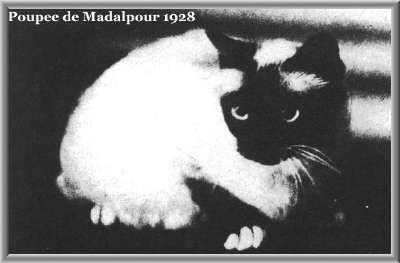 Whatever the name of their new owners, most historians agree that the original two cats were shipped to France and that the male died on the way.
Whatever the name of their new owners, most historians agree that the original two cats were shipped to France and that the male died on the way.
The female, named Sita, is said to have been in kitten and to have produced a kitten named Poupee de Madalpour.
The Early Birmans
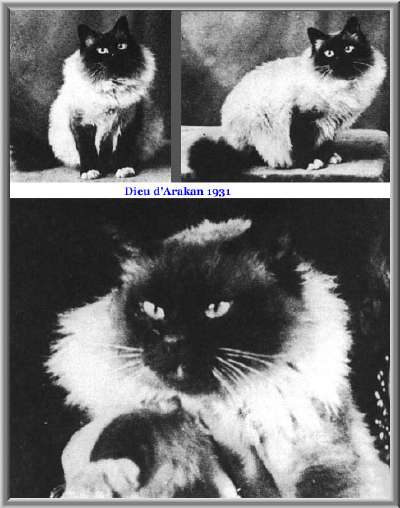 In 1925 it is recorded beyond doubt that the Federation Feline Francaise recognized the Sacre de Birmanie as a championship breed. A photograph taken in 1930 shows a male of the day named Dieu d'Arakan which became the blue-print for the breed. He was owned by M. Baudoin- Crevoisier, well known as a breeder of Birmans at that time. Later Dieu d'Arakan was sold, together with six other Birmans, to Princess Ratibor and she subsequently left them in her will to the Duke d'Aosta. Eventually their ownership was transferred to the Countess Giriode Panissera and their pedigree line became famous worldwide. During the war M. Baudoin- Crevoisier managed to keep a few cats entire. His champion male Orloff de Kaabaa and his female Xenia de Kaabaa became the breed's foundation cats.
In 1925 it is recorded beyond doubt that the Federation Feline Francaise recognized the Sacre de Birmanie as a championship breed. A photograph taken in 1930 shows a male of the day named Dieu d'Arakan which became the blue-print for the breed. He was owned by M. Baudoin- Crevoisier, well known as a breeder of Birmans at that time. Later Dieu d'Arakan was sold, together with six other Birmans, to Princess Ratibor and she subsequently left them in her will to the Duke d'Aosta. Eventually their ownership was transferred to the Countess Giriode Panissera and their pedigree line became famous worldwide. During the war M. Baudoin- Crevoisier managed to keep a few cats entire. His champion male Orloff de Kaabaa and his female Xenia de Kaabaa became the breed's foundation cats.
The name Birman is from the French spelling for Burma. "Birmanie." American Breeders follow an old French tradition. of naming kittens alphabetically by the year they are born in. For example, 2002 is "Z", 2003 is "A", 2004 is "B" and so on. By following this tradition it is easy to tell a cat's age just from its name. (Note: the first word in a cats name is the breeders cattery, then the cats name, then if required the current owners cattery)
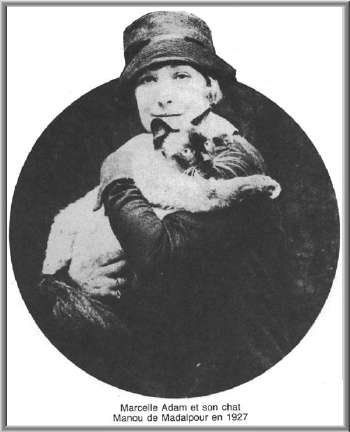 |
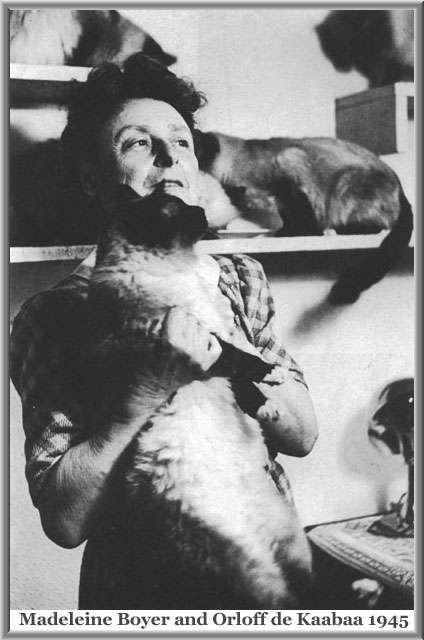 |
Migration
In Germany a line of Birmans was maintained by Hanna Kreuger of the von Frohnau cattery and Liselotte von Warner of the von Irak cattery. Together with descendants of Orloff and Xenia they formed the nucleus of the post-war breeding stock.
The Birman first traveled to the USA in 1959 when Dr and Mrs Siepel of the Janacques cattery imported a male, Irrouaddi du Clos Fleuri.
Birmans arrived in Britain in 1964 when a male and two females were sent from France to Elsie Fisher and Margaret Richards. These two breeders registered a joint cattery name, Paranjoti.

Cats In Thailand in the 1960s'
The following article about a journey to Thailand was written by Daphne Negus, who has bred Korat cats with the cattery name Si Sawat since 1964. Here she tells the story about how she went to Thailand to bring home Korats for her and her friends' breeding programs. The article was published in CFA's yearbook 1969. Reprinted with kind permission from Mrs. Negus.
Ulrika Olsson, 2003
Picture Story of a Journey to Thailand
(Or a Trip for Nine Korat Cats)
By Daphne Negus
|
(1) Mrs. Constance C. Cullen |
En route to Bankok, I stopped over in Honolulu to visit Mrs. Constance C. Cullen (1). She has a pair of Korat cats from the Malaid cattery of Mr. Sunti Sriskoon, Bankok. Ch. Malaid's Dok Malivalaya of Kane (Imp), and son, Kane's Kasem, whose sire is Ch. Malaid's Khun Phan of Kane (Imp).
Upon arrival in Bangkok, I contacted my Thai friends. I had met some of them and others were friends through correspondence about "our" cats.
Mr. and Mrs. Sunti Sriskoon, and their son, display a sister of Ch. Malaid's Khun Phan of Kane (Imp), and the trophy she won on the Chanel 4 Thai TV cat show in May 1968. The writing on the Malaid Cattery sign is auspicious, by a monk (2).
Kuhn Sunti holding Malaid's Doklao (3). He sent me a daughter of Doklao in 1967. Quad. Ch. Malaid's Noi of Si Sawat (Imp) was A-A and A-W Female Korat in 1967-68, and top Female Korat in the S.W. Region in 1968-69. Khun Sunti's spacious, well-designed cattery has grassed runs in front of each house.
 |
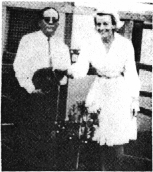 |
| (2) Mr. and Mrs. Sunti Sriskoon and their son | (3) Khun Sunti holding Mulaid's Doklao |
|
(4) Mme. Ruen Abhibal |
I was very anxious to meet one of Thailand's most famous cat breeders and judges, Mme. Ruen Abhibal Rajmaitri (4). We spent a great deal of time enjoying one another's company and talking about cats. She has some beautiful Siamese, Korat and "Copper" cats. This picture was taken on her patio. She is holding the eleven year old daughter of Mom Noel. Mom Noel is one of the famous Korats from her Mahajaya cattery. She is the dam of Nara and Darra who arrived in the U.S. in 1959. With Khunying Aghibal is Dr. Jit Waramontri, D.V.M. and his charming wife, (seated).
Another of Khunying Abhibal's female Korats (5), Mahajaya Ling Dum, born December 16, 1966. (Photo by Pichai Vasnasong)
In Thailand there are all-over brown cats known as the Supalak, Thong-Daeng or "Copper" cats (6). These are the equivalent of our Burmese. I was in four homes where there were Coppers. Khunying Abhibal has some of these cats. Here is one of hers, a one year old female, named Cham-pa. (name of a deep yellow flower that is used in Thai garlands).
A gold eyed white Spay (7), called Miss Taipei. She arrived from Thaiwan after having been surreptitiously exchanged at the port for a Siamese cat from Khunying Abhibal. Cats are not allowed to enter Taiwan. She is pure glistening white. Her tail is straight.
In Thailand there are all-over brown cats known as the Supalak, Thong-Daeng or "Copper" cats (6). These are the equivalent of our Burmese. I was in four homes where there were Coppers. Khunying Abhibal has some of these cats. Here is one of hers, a one year old female, named Cham-pa. (name of a deep yellow flower that is used in Thai garlands).
A gold eyed white Spay (7), called Miss Taipei. She arrived from Thaiwan after having been surreptitiously exchanged at the port for a Siamese cat from Khunying Abhibal. Cats are not allowed to enter Taiwan. She is pure glistening white. Her tail is straight.
|
(5) Mahajaya Ling Dum |
|
(6) Supalak, Thong-Daeng or "Copper" Cat |
The evening romp in Khunying Abhibal's gorgeous garden (8). The young male Seal Pt. standing mid-photo is imported from Japan, of English bloodlines. In the background, maids keep a constant watch, with cockers and puppies. Good cats and dogs are in danger of being stolen and taken to be sold in the Sunday market. During their exercise periods, the cats and dogs are guarded by maids and gardeners as well as by Khunying Abhibal herself. One of the veterinarians in Bangkok told me that eighty per cent of the animals purchased at the Sunday market die after reciept of immunizing shots - dogs come down with distemper, cats with enteritis. It is known as "the Sunday Market
|
(7) Miss Taipei |
(8) Evening romp in the gardens |
|
(9a) At Wat Jayapoomdaram |
|
(9b) Chinese girl holding Khun Mae |
At Wat Jayapoomdaram (which means a place where all evil has been transcended), (9a), in Bangkok's Chinatown, Khun Sunti (standing) assists me in getting applications for registration completed for the two Korat kittens, Sanouk of Holliday (Imp) and Sunetra of Si Sawat (Imp) who were given to me by Khunying Abhibal. Sanouk and Sunetra were born in the Wat, or Temple. There were many Korat cats there. They are the pets of the Chief Abbot. He had allowed Khunying Abhibal to have these two after first cautioning her not to select any with kinked tails. In Thailand, a kink or crook in the tail gathers added good luck for the cat's owner! The Chief Abbot could not sign the forms, he said it would not be proper, so the breeder is shown as the Temple itself.
The little Chinese girl is holding Khun Mae (Honorable Mother) (9b), dam of Sanouk (Festival) and Sunetra (Beautiful Eyes). The lady is holding a young male. I asked for him, but the Chief Abbot refused to release any more of his cats because thieves had come in and stolen three.
(9c) Nin Noi, sire of Sunetra and Sanouk, and *his* sire, Nin Yai. Noi means little or junior, and Yai means big or Senior (9d)
|
(9c) Nin Noi, sire of Sunetra |
(9d) Noi means junior, Yai means senior |
The site of the capital of Thailand has moved throughout its history (10). From 1350 to 1767, Ayudhya, north of Bangkok, the present capital, was the seat of government. Ayudhya was brought to ruins finally in wars with the Burmese, who set fire to chedis such as these to melt the gold off them.
Not far from Ayudhya (11) is Bangpa-In, thaditionally a place of relaxation for the Royal Court. Set in formal gardens, alongside the Chao Phraya River, its serene beauty leaves a lasting impression. I am standing on the bridge with our friend, Anurak Thananan. Behind us is the Pavilion, on the water. The "Floating Palace" is in the background. Note architecture of bridge and palace, influenced by the Italian and French architects imported by King Chulalongkorn, the Fifth King of the present ruling Dynasty.
Celebrated lawyer (12), Khun Luang Paripon Pochanapisuti, who has bred Si-sawat cats for thirty-five years. He also breeds Siamese in his spacious cattery in Bangkok. I brought home two cats from his cattery - Sook Chai of Ko-Si (Imp) (in photo with Khun Luang) or "Full of Happiness", and Boon-nam of Holiday (Imp) or "Sent by Fortune".
|
(10) Ayudhya, capital of Thailand |
(11) Bangpa-In |
(12) Khun Luang Paripon Pochanapisuti |
Mrs. Rutana Sundarodyan (13) has a bookbinders shop near the Grand Palace in Bangkok. Her customers are treated to an opportunity to pet the many Korat and Siamese cats who relax or sleep on the counters. This is Chokdee, sire of Nongchai of Si Sawat (Imp) who now lives with me. Nongchai means Little Brother.
The kitten is Nongchai of Si Sawat (14) (Imp), male kitten, at 7 1/2 weeks. With him is Sook Chai of Ko-Si (Imp), at seven months, from Khun Luang Paripon. As I located the Korat cats, some of them moved into my hotel with me. The Management gave me a refridgerator for their food.
I visited Dr. Piyawat Poothongtong, D.V.M., (15) at her clinic. She also has a clinic at the Livestock and Pets Department of the Ministry of Agriculture. I was showing her the 1967 CFA Year Book in which I had an article about Korat cats. All the nine cats I brought back had their enteritis shots and rabies vaccinations, and certificates were issued for these, before they left Bangkok.
|
(13) Mrs. Rutana Sundarodyan |
(14) Nongchai of Si Sawat and Sook Chai of Ko-Si |
(15) Dr. Piyawat Poothongtong, D.V.M. |
The explanation and verse for the Supalak, Thong-Daeng or "Copper" which is considered a very lucky cat: (As rendered by Khun Sunti)
'Supalak' cats, or Thong (gold) Daeng (red) actually means Copper colored cats. Supa means good, beautiful, progressive; lak or laksana means characteristic. Hence, Supalak cat means a cat of beautiful characteristics.
"The Characteristics of the Thong Daeng cat surpass the characteristics of all others in existence."
"Their coat color glitters like copper bright; Their eyes shine like the glittering sun on high; All harmful things will be driven away and all evils be converted to benevolence."
The ancient and famous "Smud Koi" (16) or Papyrus Book, in Bangkok's National Museum, shows, in color, paintings of favorite cats of Thailand, each described by a verse. The top one is an all black cat. Next is the Supalak (or Thong Daeng or "Copper".) Then comes the Gow Tham, or Nine Point, a white cat with large black spots on it. Then there is our silver blue Korat, or Si-Sawat cat. Below this is a black cat with a white stripe all down his back and tail. The next is called the Ratana Kampon, or "Martial Gem" because the band round its middle resembles an officer's sleeve band. This cat has a body that is pink like the inside of a conch shell. Nobody I have met has seen one. Next, we all recognise the Seal Point Siamese cat, or Vichien Mas ("Diamond Mouth") and so on.
Competition at cat shows is stiff and trophies are gorgeous (17). This charming family of Korat cats, dam, sire and two kittens, are grouped round the huge silver cup they won for their owner and breeder, Mrs. Sa-ang Suravadi of Bangkok. Kuhn Sa-ang's first Korats came from Korat, in N. E. Thailand, many years ago. When Khun Sunti first took me to see her, she had eleven Korat cats, plus Siamese and a "Copper". Three of her Korats, Nudta of Full House (Imp), Ma-dee of Si-K'iu (Imp) and a kitten, Tong-goi of Brandywood (Imp) came back with me to the U.S.
|
(16) Smud Koi |
(17) Owned by Mrs. Sa-ang Suravadi |
(18) Khun Sa-ang's Korats |
(19) Ma-dee of Si-K'iu |
I took this shot of some of Khun Sa-ang's Korats (18). Note the "Copper" in front of the table leg, at center. (The faintly spotted effect is a trick of the camera flash and is not visible to the naked eye.)
I am holding Ma-dee of Si-K'iu (Imp) who came to the U.S. with two other beautiful females of Khun Sa-ang's... (19).
|
(20) Yani and Chalama |
(21) Ma-dee of Si-K'iu |
(22) Stone statue of tiger and her cub |
Yana and Chalama, two Korat females (20). Chalama had a notion travel with me, too; she sat in one of the carriers for most of the day before the sisters left for California. However, Yani and Chalama were not to leave Bangkok. Khun Sa-ang's cats all have the run of her home.
Ma-dee of Si-K'iu (21) (Imp) now lives with Miss Catherine Barclay of Boulder, Colorado. She has made championships and Finals at the shows.
Stone statue of a tiger and her cub (22), at Wat Arun (Temple of the Dawn) across the river from Bangkok. Chinest stone sculpture.
|
(23) Chief of Customs, Mr. Chalaw Chowadee |
Gow, Nine, is the lucky number in Thailand. My ninth cat was given to me by the very important gentleman in picture 23, the Chief of Customs, Mr. Chalaw Chowadee. I am at his home, with my friends, Pongpan Dhiensiri and Anurak Thananan, who had brought me to see him at his request.
Khun Chalaw knew that his cat, whom he had brought with him from Korat Province, was going away somewhere. Hearing of my search for si-sawats, he said I was to come and see him. While I was there, his cat, Chalaw Supp of Si Sawat (Imp) walked in and got into my lap.
Khun Chalaw then gave her to me. The day before she left home, she went over to her two kittens from a previous litter and washed them all over, then went and sat in her carrier that was to bring her to California. The whole family burst into tears at the touching farewell.
|
(24) Chalaw Supp of Si Sawat |
My ninth cat, Chalaw Supp of Si Sawat (Imp) (24).
In customs at Bangkok Airport (25). Khun Sa-ang, center, seated with Miss Malee, her sister, and myself. They brought the three lovely Korat females to the airport and waited to see them off.
The nine cats traveled the twenty-four hour flight very well and they would have suffered no ill-effects at all if whoever gave them their food and water at Honolulu had not neglected to remove their water dishes from their carriers!
I had provided dishes and jars of baby food for the flight. We touched down in Hong Kong, where the crew were too busy feeding monkeys to take care of the cats, and in Tokyo, where I insisted on their being fed regardless.
But in Honolulu I was going through Customs myself so had no control over the feeding. Some of the cats suffered a chill from water soaked bedding. However, they eventually recovered and they adapted very quickly to their new surroundings.
Biographical Note
|
(25) Khun Sa-ang, center, seated with |
Born in London, England. After working in film production in England and Europe, Warner Bros. "imported" me for an overseas film location for most of 1952. I settled in Los Angeles as a resident alien in 1953. Now a U.S. Citizen, married to Richard Negus who was also born in London, my interest in the Cat Fancy began in 1961-62, with Siamese and Burmese. While showing Burmese in 1964, I saw my first Korat cat, Arcadia's Jami, exhibited by Mr. and Mrs. Ray F. Gardner in Northridge, California.
I have been Secretary of the Korat Cat Fanciers Association, an unaffiliated breed society, since its inception in March 1965. In October, 1968, I set off for Thailand on a Korat quest - to find and bring back fresh bloodlines.

